Who are you and what startup did you build?
I'm Krish, a frontend developer currently working remotely for an Australian-based startup while living in Mumbai, India. My journey into tech wasn't traditional, I originally studied mechanical engineering, but during COVID, I realized I lacked the skills and confidence I needed for my future. That uncertainty pushed me to start learning programming from scratch. After a year of building projects and getting comfortable with code, I discovered the indie hacking community on Twitter and platforms like Product Hunt.
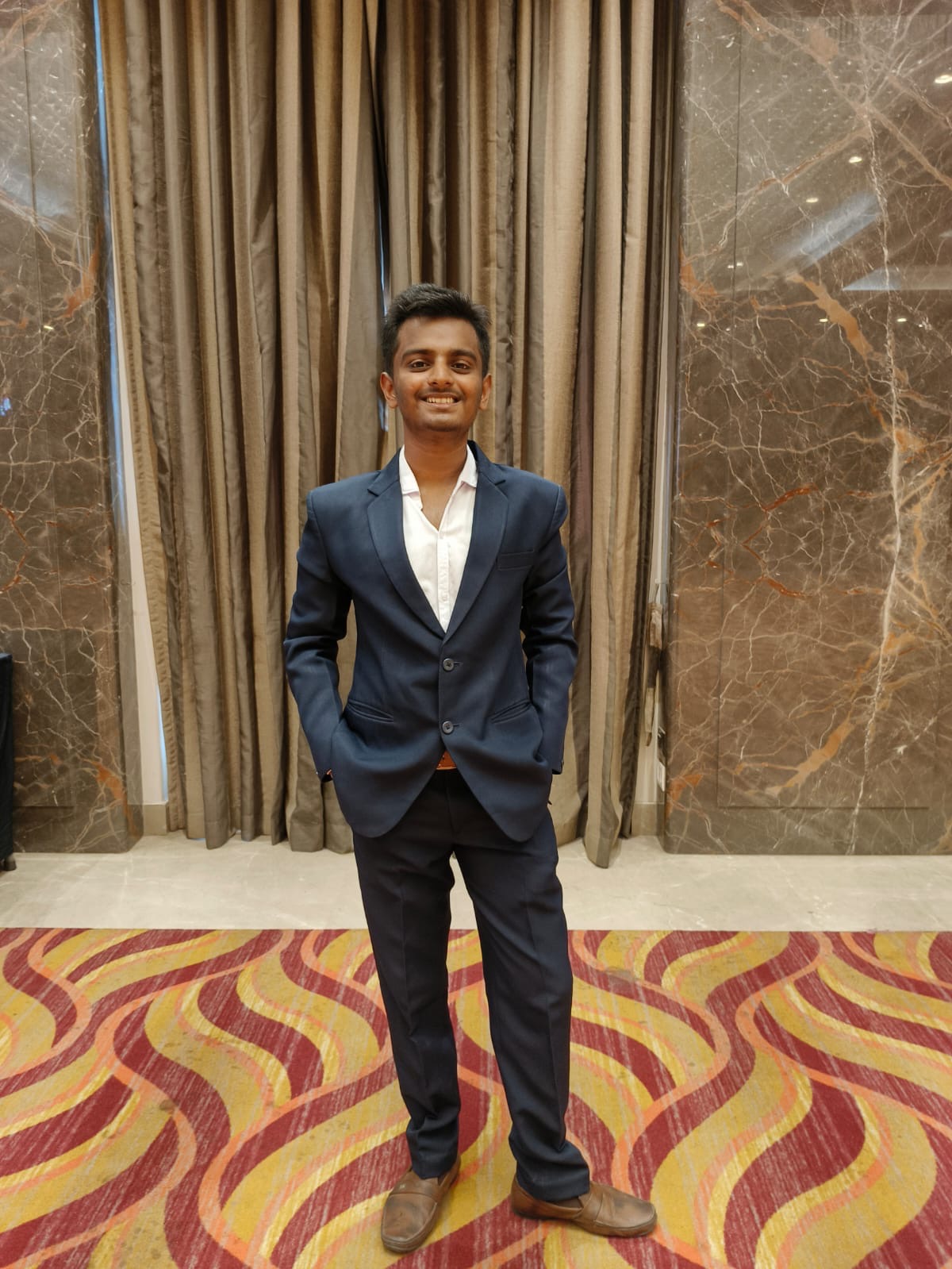
The entrepreneurial bug bit me when I saw creators sharing beautiful tweets with gradient backgrounds and realized there wasn't a simple tool to create those eye-catching visuals. That spark of inspiration led me to build Picyard. Even though I had landed a mechanical engineering job, I decided to pivot my entire career toward software engineering and was fortunate enough to secure a remote development opportunity. What drew me to indie hacking was the freedom it offers, the ability to work on something you're passionate about while maintaining control over your time and creative direction.
Picyard became my solution for transforming boring screenshots into stunning, professional-looking visuals. It's an all-in-one design platform that helps anyone create beautiful mockups, device frames, code snippets, social media graphics, and more, all without requiring any design skills. From simple screenshot enhancement to complex device mockups for app store listings, Picyard makes visual content creation accessible to developers, marketers, content creators, and anyone who wants their images to stand out. The platform grew to serve thousands of users who needed to quickly turn ordinary screenshots into eye-catching visuals for their projects, social media, and marketing materials.
How did you come up with the idea?
The idea for Picyard came directly from my own frustration as a Twitter user. I kept seeing creators sharing these beautiful, eye-catching screenshots with gorgeous gradient backgrounds that made their content pop in the feed. When I tried to find tools to create similar visuals, I discovered that all the existing solutions came with hefty monthly subscription fees, often $20-50+ per month. As someone just starting out in tech, those prices felt completely out of reach for what should be a simple image enhancement tool.
I decided to scratch my own itch and build a free alternative. The beauty of the concept was that it could work entirely in the browser without needing any backend infrastructure. Users could upload their screenshots, apply beautiful backgrounds and effects, and download the results without any of their data ever leaving their device. This privacy-first approach felt like a major advantage over existing tools. I wasn't dreaming about this product for months; it was pure necessity that drove me to action.
I built the first version as a single-page application in just 2 days and immediately launched it on Product Hunt. The response was incredible: it resonated with so many creators who had the same problem I did. Over the next two months, I went into iteration mode, adding features like device mockups, code snippet styling, and social media templates based on user feedback. Eventually, I monetized it with affordable lifetime deals instead of expensive subscriptions, staying true to my original vision of making great design tools accessible to everyone.
What was the first version of your product?
I built the first version using Next.js, MongoDB, Stripe, Vercel, and Cloudflare R2 for static assets. This tech stack was a natural choice since I was already comfortable with the MERN stack, and these tools offered exactly what I needed: fast development, scalability, and generous free tiers. Next.js gave me the flexibility to build both client-side image processing and server-side features, while Vercel made deployment seamless. I leveraged ChatGPT and Claude AI as my coding assistants throughout the process, which significantly sped up development and helped me solve technical challenges quickly.
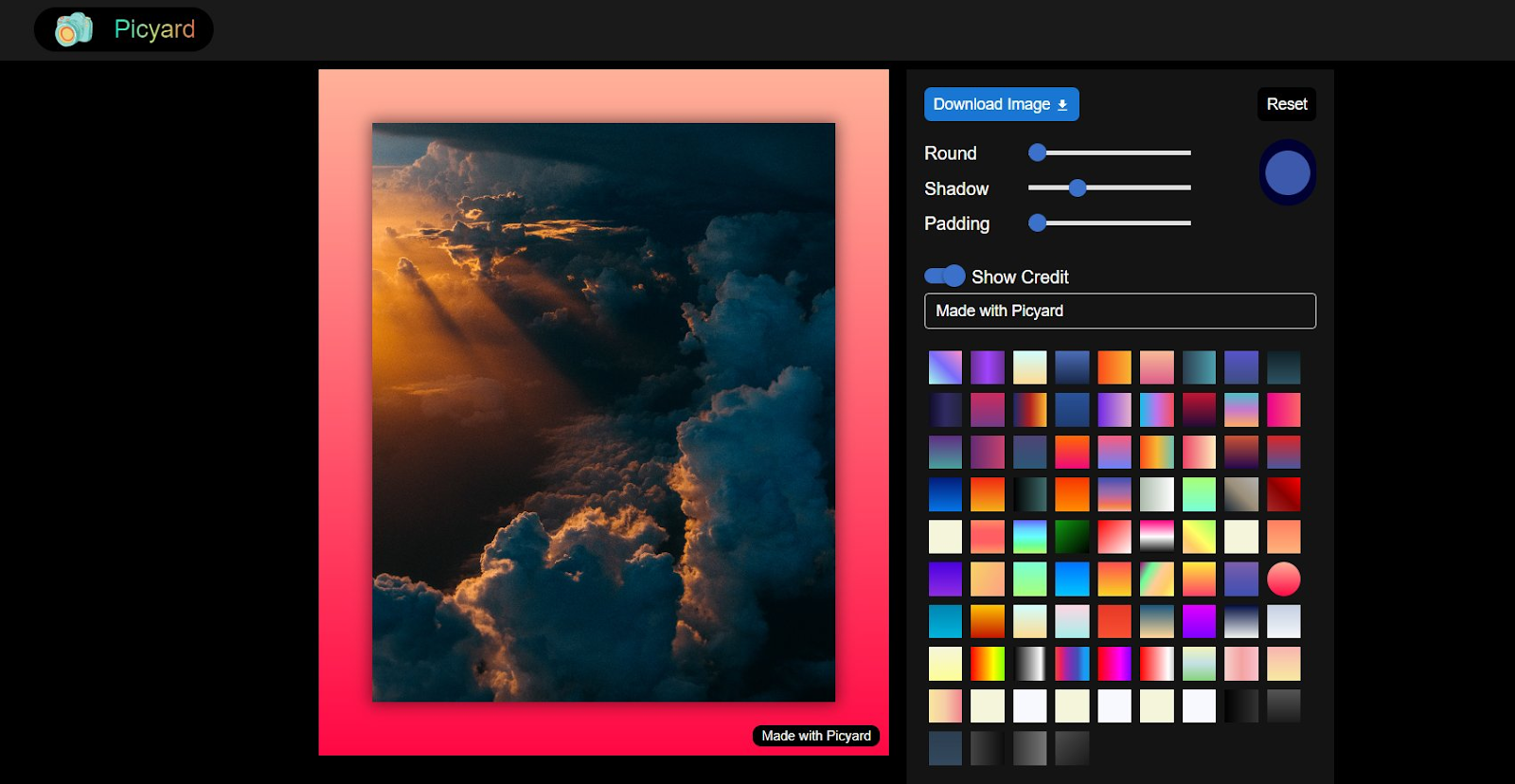
I designed the interface myself, iterating constantly and drawing inspiration from tools like Canva and other existing screenshot enhancement solutions. The approach was scrappy but effective. I focused on making the core functionality work first, then gradually polished the UI based on user feedback. The beauty of keeping everything browser-based meant users could upload images, apply effects, and download results without any backend processing, which kept costs minimal and privacy intact.
One of my biggest wins was keeping expenses practically zero, just domain renewals, since I used free tiers for hosting and storage. However, my biggest mistake was not launching with a paid plan from day one. I learned this lesson the hard way: having a monetization path from the start not only validates demand but also creates the financial motivation to keep improving the product. If I could do it again, I'd launch with both free and premium tiers immediately, even if the premium features were simple at first. This would have given me faster feedback on what users were willing to pay for and created sustainable momentum from the beginning.
How did you launch your project?
I chose to launch Picyard on Product Hunt and Twitter simultaneously, focusing most of my energy on the Product Hunt launch since I'd seen other indie makers have success there. Product Hunt felt like the natural choice because it's specifically designed for discovering new tools and has an engaged community of early adopters, developers, and creators. I didn't do extensive preparation; I simply believed in the product solving a real problem and wanted to get it in front of people as quickly as possible.
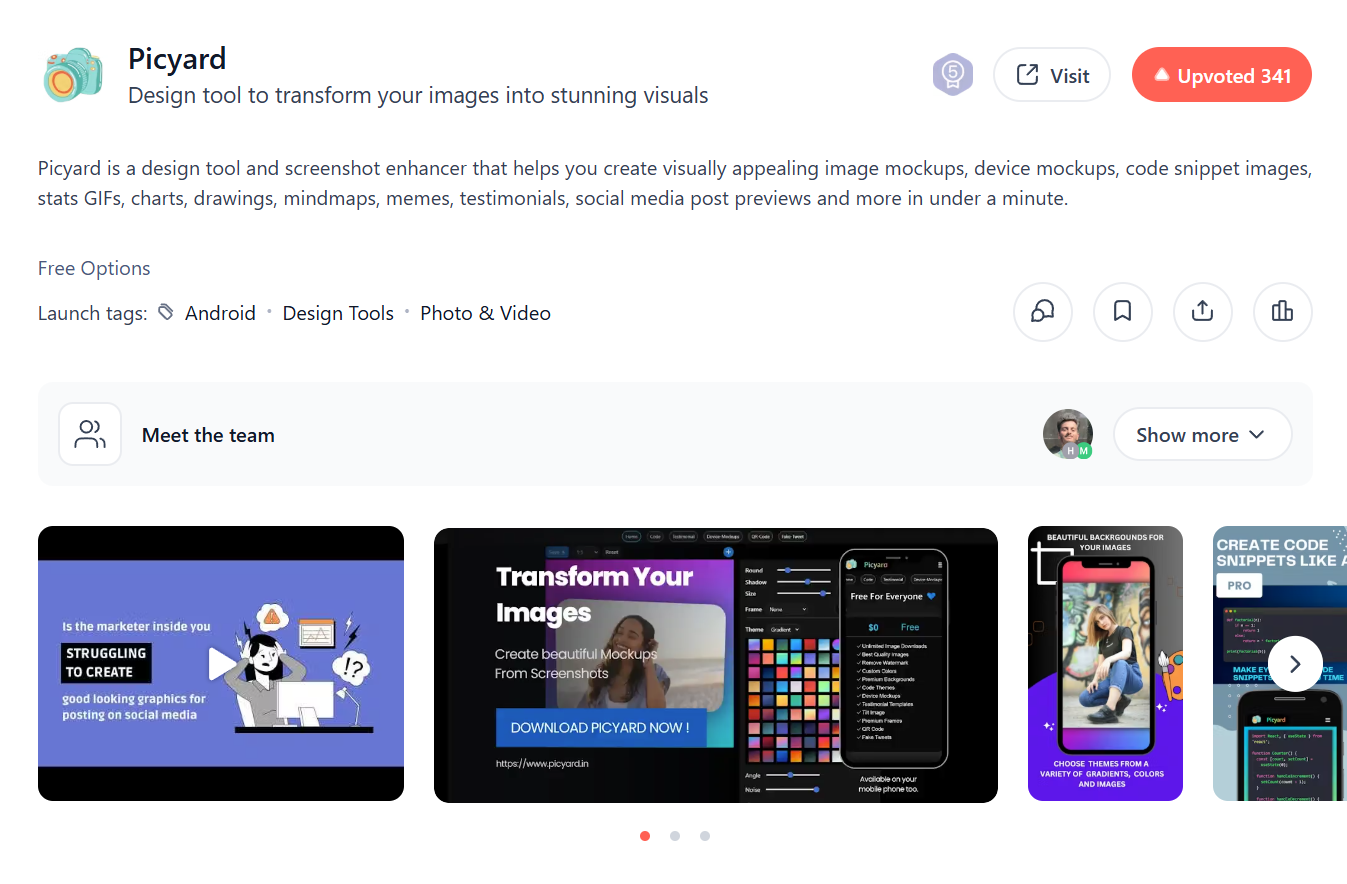
The launch was entirely a solo effort with zero budget. I just prepared some screenshots, wrote a compelling description, and submitted it to Product Hunt while simultaneously sharing it on Twitter. While Twitter didn't generate much immediate traction, the Product Hunt launch was a different story. We ended up with around 100 upvotes, which might not sound huge, but it was enough to get noticed by various tech blogs and websites that started featuring Picyard in their "new tools" roundups and lists.
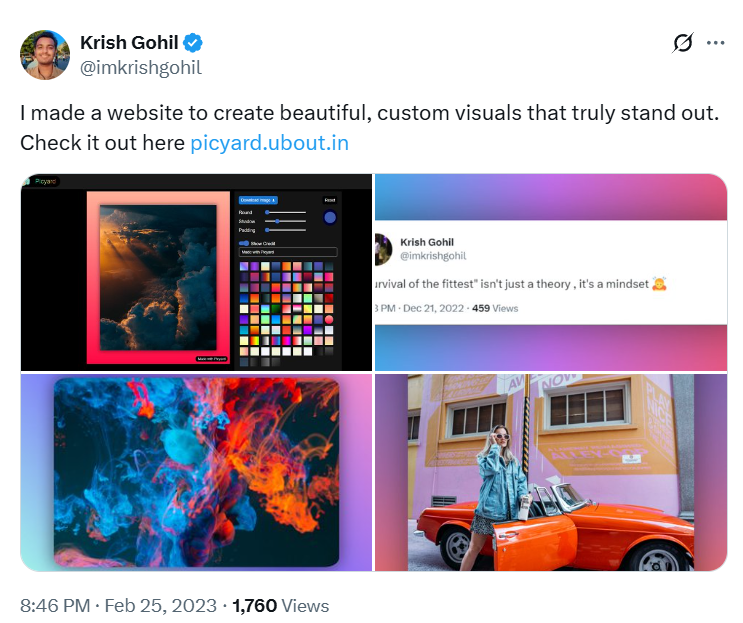
The real value wasn't just the upvotes, it was the organic coverage that followed. Multiple websites picked up the story and mentioned Picyard in their articles about design tools and productivity apps. This created a snowball effect of backlinks and mentions that drove consistent traffic for weeks after the launch. The whole process taught me that sometimes the best launch strategy is just shipping something useful and letting the community decide if it's worth sharing. The time investment was minimal, but the long-term benefits of that initial Product Hunt validation were huge for building credibility and getting those first crucial users.
After launch, what was the best growth strategy?
My growth strategy was entirely organic and focused on being genuinely helpful in communities where my target users were already hanging out. I spent most of my time writing tweets and engaging on Reddit, particularly in subreddits related to design, programming, and content creation. The key was not just dropping links but actually participating in conversations, answering questions, and sharing valuable insights about design and productivity. What surprised me was how much traction I got from Facebook lifetime deal (LTD) groups, these communities are full of entrepreneurs and creators always looking for new tools, and they became a goldmine for both feedback and sales.
I managed all the marketing myself as a solo founder, which meant spending time in comment sections on Reddit and Twitter, responding to questions and genuinely trying to help people solve their design problems. It sounds tedious, but it was actually fun. I got to connect directly with users, understand their pain points, and build relationships with the community. My landing page had a solid 1-2% conversion rate, which felt good for organic traffic where people were discovering the tool through word-of-mouth rather than targeted ads.
My entire growth toolkit was basically just me, my keyboard, and occasionally AI assistants like ChatGPT to help polish posts and make them sound more engaging. The best ROI came from simply being authentic and helpful, when someone posted "How do I make my screenshots look better?" in a Reddit thread, I'd share genuinely useful tips and mention Picyard as one option among several. This approach built trust and led to users who weren't just customers, but advocates who would recommend the tool to others. The organic nature meant growth was slower but more sustainable, with users who really understood and valued what Picyard offered.
How did you monetize your venture?
I went with a lifetime deal (LTD) model priced at $20, which felt like the perfect fit for Picyard's nature as a frontend tool with minimal recurring costs. Since all the image processing happened in the browser and I was leveraging free tiers for hosting, I didn't have the typical SaaS overhead that would justify monthly subscriptions. The LTD model was much more attractive to buyers instead of yet another monthly expense, they could pay once and use the tool forever. This aligned perfectly with my original vision of making design tools accessible and affordable, especially for indie hackers and solo creators who are often budget-conscious.
The main challenge wasn't technical but psychological. Сonvincing users that the one-time $20 price was genuinely worth it and that they'd truly have lifetime access to the product. I had to build trust that this wasn't just a cash grab, but a sustainable model where their investment would pay off over time. Setting up Stripe was straightforward, and from there it was mostly about hoping nothing would go wrong with payments and continuously demonstrating value to justify the price point. The beauty of the LTD model was that once users bought in, there was no churn to worry about, just focus on making the product better.
I managed all the finances myself, keeping things simple with Stripe for payments and Wise connected to my bank account for international transactions. Since the cost structure was so lean, basically just domain renewals and minimal hosting costs, tracking profitability was straightforward. The LTD model created immediate cash flow that I could reinvest into product improvements, and the lack of recurring revenue stress meant I could focus on building features that users actually wanted rather than optimizing for retention metrics. It was a business model that matched both my technical setup and my philosophy of creating lasting value for users.
How much did you get after exit?
I sold Picyard for $6,000 through the Microns platform. The process was surprisingly smooth. I just chatted with the buyer directly on Microns, and everything went seamlessly from there. The deal was structured as a straightforward cash transaction, which I appreciated for its simplicity. No complicated earnouts or equity arrangements, just a clean handoff of the product and its user base.
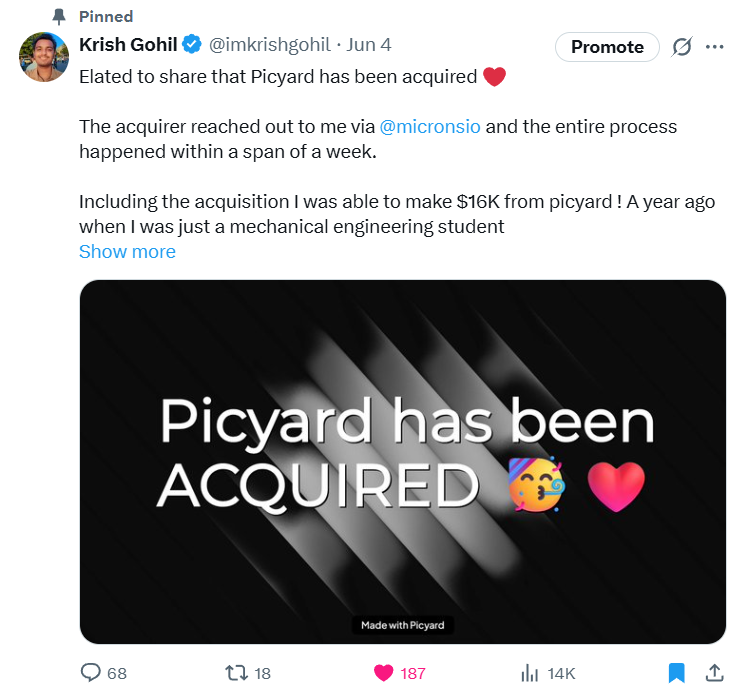
When the money hit my bank account, I felt genuinely good and relieved. It wasn't about the amount as much as it was about closure and validation. After months of building, iterating, and supporting users, I was ready to move on to something new and learn different things. The sale gave me the freedom to explore other ideas without the ongoing responsibility of maintaining Picyard. It felt like the right time to pass the torch to someone who could take it to the next level.
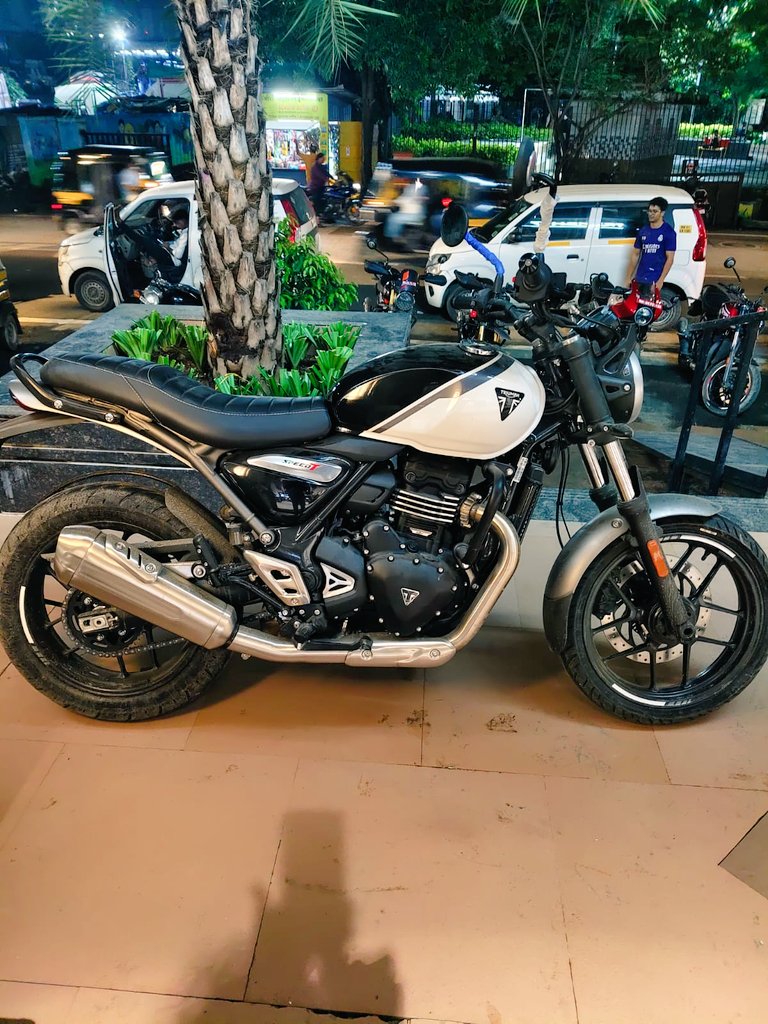
I celebrated by buying myself a motorbike. Something I'd been wanting for a while but kept putting off. It felt like the perfect way to mark this milestone and give myself something tangible to remember this journey by. The rest of the money is set for my next venture, whatever that might be. The Microns platform made the entire exit process straightforward, and I'd definitely recommend it to other indie hackers looking to sell their projects. Sometimes the best outcome isn't holding on forever, but knowing when to let go and move on to the next adventure.
What do you plan to do next? And what help do you need?
Right now, I'm focusing on excelling at my current frontend developer role while building my next project on the side. I'm working on ProdPapa.com, a product launching platform that combines the best of product discovery with social proof. The concept is simple but powerful: users can review products, companies can collect those reviews and showcase them as testimonials on their websites, and they get a trust badge (similar to Trustpilot) to display as a credibility signal. The launch process itself drives visitors to the product, creating a win-win cycle where companies get both reviews and traffic, while users discover genuinely useful products.
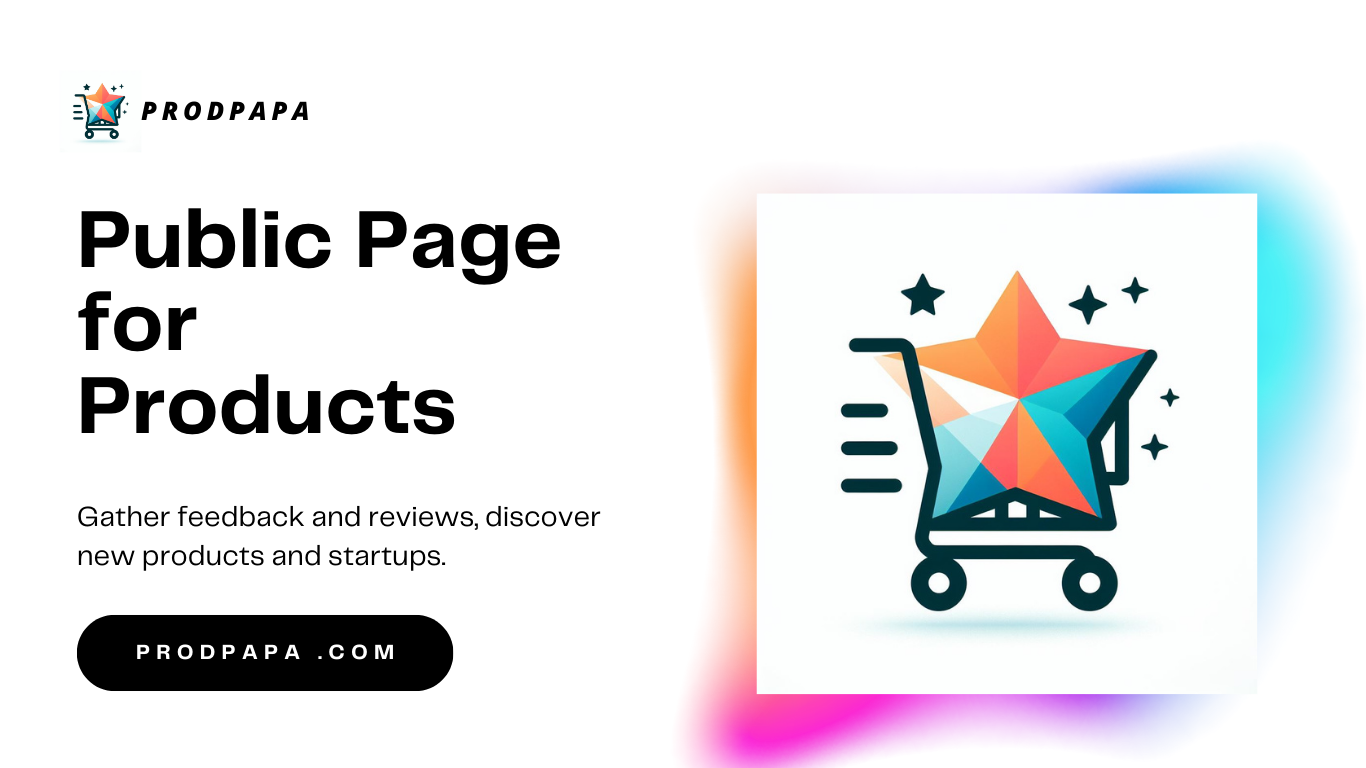
I'm also excited about a journaling app concept I've been sketching out for the future. Imagine a personal journaling experience with a Twitter-like feed where you can share selected thoughts with a community. It's still in the idea phase, but I love the potential of combining private reflection with optional social sharing. The goal is to make journaling more engaging and less isolated while still preserving the personal, introspective nature that makes it valuable.
Honestly, I'm not looking for any help right now. I've discovered that I genuinely love working solo. There's something deeply satisfying about having complete creative control and being able to move at my own pace without needing to coordinate with others. The indie hacker lifestyle suits me perfectly: I can experiment with ideas, pivot quickly when something isn't working, and keep my overhead minimal. Maybe that'll change as projects get bigger, but for now, the freedom and simplicity of solo building is exactly where I want to be.
One person, one book and one site that affected you the most
.png)
Person: Elon Musk has been a huge influence on my entrepreneurial mindset, not just for his achievements but for his approach to solving problems and thinking from first principles. His willingness to tackle seemingly impossible challenges and rebuild entire industries from the ground up taught me that you don't have to accept the status quo, sometimes the best solutions come from questioning everything and building something completely new.
Book: The Bhagavad Gita has profoundly shaped how I approach both business and life, teaching me about detachment from outcomes while still giving your best effort. The concept of focusing on the process rather than being anxious about results has helped me stay calm during the ups and downs of building products, and the emphasis on dharma (doing what's right) keeps me grounded in creating genuine value for users rather than just chasing quick profits.
Site: Twitter has been absolutely transformative for my journey as an indie hacker. It's where I discovered the entire indie hacking community, learned about tools and strategies in real-time, and got inspired by people building in public. The platform taught me the power of sharing your work openly, connecting with like-minded builders, and learning from others' successes and failures. It's like having a 24/7 mastermind group of entrepreneurs in your pocket.
Wisdom for other startup founders
My biggest piece of advice is simple:
Don't overthink it — just launch and get feedback from real users.
I see too many founders spending months perfecting their product in isolation, trying to anticipate every possible user need. With Picyard, I built the MVP in 2 days and launched immediately on Product Hunt. That early feedback was invaluable and shaped the entire direction of the product. Momentum is everything in the early stages, and you can only build that momentum by putting something real in front of people and seeing how they respond.
If something doesn't gain traction after giving it a genuine effort, don't be afraid to put it aside and work on something else. I've learned that market demand drives sales, and you need to respect that reality rather than trying to force people to want something they don't need. The market will tell you what it wants. Your job is to listen and build for that demand, not to convince people they need your particular solution. Sometimes the best thing you can do as a founder is know when to pivot or move on. There's no shame in building multiple small products until you find the one that really resonates. The key is to keep shipping, keep learning, and stay responsive to what users actually want rather than what you think they should want.




.png)





